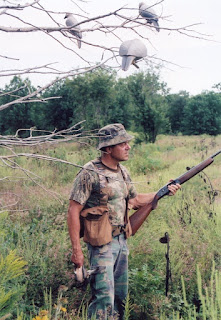I really believe that the whippoorwill and it’s
larger relative, the chuck-will’s-widow, are two birds that are headed for
possible extinction or something close to it. I know that to some that sounds
pretty extreme but those who live in the country where woodlands are near, know
what I am talking about.
I
am getting letters from Wright and Texas counties saying there seems to be none
of them to be heard anywhere. I
use to camp on river gravel bars and hear a half dozen of those mesmerizing
night birds calling their repetitive song around me, and go to sleep listening
to them.
Now
you may float the rivers and camp in a different place every night and be lucky
to hear one. Here on Lightnin’ Ridge twenty years ago, you could figure on
hearing both birds, and several of them, in the big woods beyond my home and
office. This summer as last, there were none. Not one of either. Without the two, the night-time woods
is a place too quiet, empty and dark.
The
reason behind their diminishing numbers is pretty easy to figure. They lay eggs
in the leaves in the woods and build no nests. The two species are creatures of
flight, and incapable of walking efficiently on weakly muscled legs. They eat
nothing on the ground, just insects in the air, when in flight at dusk and
dawn. Because of that you cannot
raise them in captivity… they cannot be fed in a confined environment.
Both
hogs and armadillos and all other ground rummaging furbearers, like raccoons,
skunks, and possums find and eat the eggs and the young birds. So do crows, and
blacksnakes are one of the most formidable of egg eaters. All of these, every single species
mentioned, is now at tremendously high populations everywhere these birds are
found. I know that the birds
decline across the Midwest began with the infiltration of non-native
armadillos, one of the most horrible creatures ever to move into our region.
Whippoorwill
eggs are too white, and often when you can walk past the bird and not see it
because it blends so well into the forest floor, you can spot the eggs many
yards away.
One protective gift they are given is the
ability to move their eggs, and their fledglings both, by holding them between
the their thighs and moving them to another safer place. Trouble is, there is no safer place now.
I might
be able to blame the increasing loss of whippoorwills on wild hogs, but here on
Lightnin’ Ridge where I live, there are no hogs. The armadillo is a scourge,
and one I cannot see any hope of eliminating.
The whippoorwill’s
range covers a larger area than the chuck-wills-widow’s range, which makes the
latter even more susceptible to this predation, of which feral hogs and
armadillos are such a great part.
The larger chuck-wills-widow exists all across the south into eastern
Oklahoma and Texas but not very far to the north, not found north of
Missouri. Whipporwills thrive into the
southern part of Canada, but not in the Deep South or Texas, nor much farther
to the west than eastern Kansas or eastern Oklahoma.
Biologists
in state wildlife departments are slow to recognize what is happening, but we
are going to have to change some attitudes in a hurry if we are going to save
the whippoorwill and other birds which nest on the ground.
Modern
day nature lovers, bird watchers and ornithologists need to get involved now,
and we have to abandon the old idea that we should let nature take it’s
course. Nature has been badly
overbalanced because of the over population of man. THERE NO LONGER IS A
‘NATURES COURSE’.
We
cannot eliminate or destroy the raccoon nor the possum or skunk no matter what
we do. When the price of furs was
high in the 1920’s through the 1950’s we saw a tremendous pressure on those
three species, and they were at low numbers for sure, for many years, but nowhere
near extinction. If those of us
who live in the country begin to eliminate them as much as we can, we can make
a significant impact on their numbers, and save many many nests.
I
have declared war on blacksnakes, feral cats and armadillos on my own
land. And I intend to reduce
populations of raccoons and possums and skunks as well. Control of these ever-increasing vermin
is best effected by learning how to set small deadfalls.
While
deadfalls are against game and fish commission regulations, they are going to
have to become a tool we use in protecting ground nesting birds like the
whippoorwill, quail, woodcock and even wild turkey. There is some kind of game
department regulation against almost anything you do now, killing a copperhead,
cottonmouth or woodrat is illegal in Missouri.
Right
now there is a decline in eastern wild turkey populations in much of the
Midwest, worse than I have seen since I was young. Again, they have never faced
such a problem with the increasing number of egg eaters. I will address that in
another column.
I
am urging everyone who spends time in the woods, who owns forested land or
wants to see quail eggs and whippoorwill eggs survive, to declare war on these
species I have mentioned. I will
eliminate all blacksnakes and armadillos on my place especially, and make it
unattractive for crows and raccoons as well. If you have noticed a decline in whippoorwill numbers in
woodlands around you, I suggest you give thought to doing the same.
Outdoors note… A quail-hunting friend of mine says he finds
several coveys, along a bottomland where a couple of farmer’s families trap fur
each winter. He says it is easy to
see why the quail do better there… trapping thins down the egg eaters.





